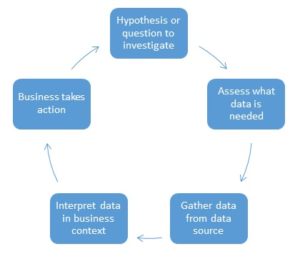It’s easy for someone looking to move into an data analytics role to think about technical skills. It’s natural for analysts and data scientists to strive to learn SQL, R, Python, etc. as those are often prerequisites for a data role.
But that’s only a small part of the story, and in my opinion, the simplest to master. What comes before and after that technical work is what truly makes an organization data driven.
Although gathering data is a vital skill, it’s the ability to form hypotheses, interpret data, and take business action that truly take someone to the next level in his or her career.
To describe this process, I’ve visualized a sample data workflow below:

I’ve simplified it to a five-step process:
- Hypothesis to investigate
- Assess what data is needed
- Gather data from data source
- Interpret data in business context
- Business takes action
An analyst or data scientist often lives in step three, as they should due to their technical expertise. However, to take the next step in their careers, analytics professionals needs to focus on steps one, two and four in the process.
That means the ability to ask the right questions and to translate the data to answer those questions. Traditionally, those are viewed as product manager responsibilities, but any great data scientist needs to have those skills as well.
And while identifying next steps based on data may seem to be the responsibility of executives, a data scientist can use his or her expertise with the data to suggest business action.
In thinking about all of these abilities together, driving business action through data is the ultimate goal. With the ability to lead in a data-driven way, the sky is the limit for any data professional.